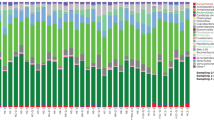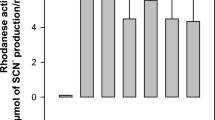Abstract
The aim of the present study is to investigate the impact of glyphosate on the microbiota and on the botulinum neurotoxin (BoNT) expression during in vitro ruminal fermentation. This study was conducted using two DAISYII-incubators with four ventilated incubation vessels filled with rumen fluid of a 4-year-old non-lactating Holstein–Friesian cow. Two hundred milliliter rumen fluid and 800 ml buffer solution were used with six filter bags containing 500 mg concentrated feed or crude fiber-enriched diet. Final concentrations of 0, 1, 10, and 100 µg/ml of glyphosate in the diluted rumen fluids were added and incubated under CO2-aerated conditions for 48 h. The protozoal population was analyzed microscopically and the ruminal flora was characterized using the fluorescence in situ hybridization technique. Clostridium botulinum and BoNT were quantified using most probable number and ELISA, respectively. Results showed that glyphosate had an inhibitory effect on select groups of the ruminal microbiota, but increased the population of pathogenic species. The BoNT was produced during incubation when inoculum was treated with high doses of glyphosate. In conclusion, glyphosate causes dysbiosis which favors the production of BoNT in the rumen. The global regulations restrictions for the use of glyphosate should be re-evaluated.




Similar content being viewed by others
References
Abou Akkada AR, Howard BH (1960) The biochemistry of rumen protozoa. 3. The carbohydrate metabolism of Entodinium. Biochem J 76:445–451
Adlerberth I, Cerquetti M, Poilane I, Wold A, Collignon A (2000) Mechanisms of colonisation and colonisationn resistance of the digestive tract Part 1: bacteria: host interactions. Microb Ecol Health Dis 2:223–239
Allison M, Maloy S, Matson R (1976) Inactivation of Clostridium botulinum toxin by ruminal microbes from cattle and sheep. Appl Environ Microbiol 32:685–688
Arregui MC, Lenardón A, Sanchez D, Maitre MI, Scotta R, Enrique S (2004) Monitoring glyphosate residues in transgenic glyphosate-resistant soybean. Pest Manag Sci 60:163–166
Benachour N, Sipahutar H, Moslemi S, Gasnier C, Travert C, Séralini GE (2007) Time-and dose-dependent effects of roundup on human embryonic and placental cells. Arch Environ Contam Toxicol 53:126–133
Benachour N, Séralini GE (2009) Glyphosate formulations induce apoptosis and necrosis in human umbilical, embryonic, and placental cells. Chem Res Toxicol 22:97–105
Böhnel H, Schwagerick B, Gessler F (2001) Visceral botulism—a new form of bovine Clostridium botulinum toxication. J Vet Med 48:373–383
Burggraf S, Mayer T, Amann R, Schadhauser S, Woese CR, Stetter KO (1994) Identifying members of the domain Archaea with rRNA-targeted oligonucleotide probes. Appl Environ Microbiol 60:3112–3119
Cakmak I, Yazici A, Tutus Y, Ozturk L (2009) Glyphosate reduced seed and leaf concentrations of calcium, manganese, magnesium, and iron in non-glyphosate resistant soybean. Eur J Agron 31:114–119
Coleman GS (1985) The cellulase content of 15 species of entodiniomorphid protozoa, mixed bacteria and plant debris isolated from the bovine rumen. J Agric Sci 104:349
Coleman GS (1986) The amylase activity of 14 species of entodiniomorphid protozoa and the distribution of amylase in rumen digesta fractions of sheep containing no protozoa or one of seven different protozoal populations. J Agric Sci 107:709
Coleman G (1992) The rate of uptake and metabolism of starch grains and cellulose particles by Entodinium species, Eudiplodinium maggii some other entodiniomorphid protozoa and natural protozoal populations taken from the bovine rumen. J Appl Bacteriol 73:507–513
Cringoli G, Rinaldi L, Veneziano V, Capelli G, Scala A (2004) The influence of flotation solution, sample dilution and the choice of McMaster slide area (volume) on the reliability of the McMaster technique in estimating the faecal egg counts of gastrointestinal strongyles and Dicrocoelium dendriticum in sheep. Vet Parasitol 123:121–131
Curwin BD, Hein MJ, Sanderson WT, Striley C, Heederik D et al (2007) Urinary pesticide concentrations among children, mothers and fathers living in farm and non-farm households in iowa. Ann Occup Hyg 51:53–56
Dahlenborg M, Borch E, Radström P (2003) Prevalence of Clostridium botulinum types B, E and F in faecal samples from Swedish cattle. Int J Food Microbiol 82:105–110
Demeyer D (1981) Rumen microbes and digestion of plant cell walls. Agric Environ 6:295–337
Duke SO, Powles SB (2008) Glyphosate: a once-in-a-century herbicide. Pest Manag Sci 64:319–325
Franks AH, Harmsen HJ, Raangs GC, Jansen GJ, Schut F, Welling GW (1998) Variations of bacterial populations in human feces measured by fluorescent in situ hybridization with group-specific 16S rRNA-targeted oligonucleotide probes. Appl Environ Microbiol 64:3336–3345
Freuze I, Jadas-Hecart A, Royer A, Communal P-Y (2007) Influence of complexation phenomena with multivalent cations on the analysis of glyphosate and aminomethyl phosphonic acid in water. J Chromatogr A 1175:197–206
Forsberg CW, Cheng K, White BA (1997) Polysaccharide degradation in the rumen and large intestine. In: Mackie RI, White BA (eds) Gastrointestinal microbiology. Springer, Boston, pp 319–379
Harmon DL, Britton RA, Prior RL, Stock RA (1985) Net portal absorption of lactate and volatile fatty acids in steers experiencing glucose-induced acidosis or fed a 70 % concentrate diet ad libitum 1. J Anim Sci 60:560–569
Harmsen H, Elfferich P, Schut F, Welling G (1999) A 16S rRNA-targeted probe for detection of lactobacilli and enterococci in faecal samples by fluorescent in situ hybridization. Microb Ecol Health Dis 11:3–11
Harmsen HermieJM, Raangs GC, He T, Degener JE, Welling GW (2002) Extensive set of 16S rRNA-based probes for detection of bacteria in human feces. Appl Environ Microbiol 68:2982–2990
Kong Y, He M, McAlister T, Seviour R, Forster R (2010) Quantitative fluorescence in situ hybridization of microbial communities in the rumens of cattle fed different diets. Appl Environ Microbiol 76:6933–6938
Krüger M, Große-Herrenthey A, Schrödl W, Gerlach A, Rodloff A (2012) Visceral botulism at dairy farms in Schleswig Holstein, Germany—Prevalence of Clostridium botulinum in feces of cows, in animal feeds, in feces of the farmers, and in house dust. Anaerobe 18:221–223
Krüger M, Shehata AA, Schrödl W, Rodloff A (2013) Glyphosate suppresses the antagonistic effect of Enterococcus spp. on Clostridium botulinum. Anaerobe 20:74–78
Krüger M, Neuhaus J, Herrenthey AG, Gökce MM, Schrödl W, Shehata AA (2014) Chronic botulism in a Saxony dairy farm: sources, predisposing factors, development of the disease and treatment possibilities. Anaerobe. doi:10.1016/j.anaerobe.2014.06.010
Lindström M, Myllykoski J, Sivelä S, Korkeala H (2010) Clostridium botulinum in cattle and dairy products. Crit Rev Food Sci Nutr 50:281–304
Loy A, Maixner F, Wagner M, Horn M (2007) ProbeBase—an online resource for rRNA-targeted oligonucleotide probes: new features 2007. Nucleic Acids Res 35:D800
Maddox PH, Jenkins D (1987) 3-Aminopropyltriethoxysilane (APES): a new advance in section adhesion. J Clin Pathol 40:1256–1257
Madsen HEL, Christensen HH, Gottlieb-Petersen C, Andresen AF, Smidsrød O, Pontchour C, Phavanantha P, Pramatus S, Cyvin BN, Cyvin SJ (1978) Stability constants of copper (II), zinc, manganese(II), calcium, and magnesium complexes of N-(phosphonomethyl)glycine (glyphosate). Acta Chemica Scand 32a:79–83
Manz W, Amann R, Ludwig W, Vancanneyt M, Schleifer KH (1996) Application of a suite of 16S rRNA-specific oligonucleotide probes designed to investigate bacteria of the phylum cytophaga-flavobacter-bacteroides in the natural environment. Microbiology 142(Pt 5):1097–1106
McCrady MH (1915) The numerical interpretation of fermentation-tube results. J Infect Dis 17:183–212
McDougald D, Rice SA, Weichart D, Kjelleberg S (1998) Nonculturability: adaptation or debilitation? FEMS Microbiol Ecol 25:1–9
Mesnage R, Defarge N, Spiroux de Vendômois J, Séralini GE (2014) Major pesticides are more toxic to human cells than their declared active principles. Biomed Res Int 179691. doi:10.1155/2014/179691
Okereke A, Montville T (1991) Bacteriocin-mediated inhibition of Clostridium botulinum spores by lactic acid bacteria at refrigeration and abuse temperatures. Appl Environ Microbiol 57:3423–3428
Ozutsumi Y, Tajima K, Takenaka A, Itabashi H (2005) The effect of protozoa on the composition of rumen bacteria in cattle using 16S rRNA gene clone libraries. Biosci Biotechnol Biochem 69:499–506
Sauer FD, Erfle JD, Mahadevan S (1975) Amino acid biosynthesis in mixed rumen cultures. Biochem J 150:357–372
Schrödl W (2009) Interaktion zwischen der intestinalen Mikrobiota und unspezifischen sowie spezifischen Effektorproteinen bei Milchkühen unter besonderer Berücksichtigung von Clostridium botulinum. Habilitation, Leipzig, Germany
Sghir A, Gramet G, Suau A, Rochet V, Pochart P, Dore J (2000) Quantification of bacterial groups within human fecal flora by oligonucleotide probe hybridization. Appl Environ Microbiol 66:2263–2266
Sieg VY (2007) Untersucungen zu “Effektiven Mikroorganismen” (EM1®), Dissertation, Halle, Germany
Thiel R, Blaut M (2005) An improved method for the automated enumeration of fluorescently labelled bacteria in human faeces. J Microbiol Method 61:369–379
Trebesius K, Leitritz L, Adler K, Schubert S, Autenrieth IB, Heesemann J (2000) Culture independent and rapid identification of bacterial pathogens in necrotising fasciitis and streptococcal toxic shock syndrome by fluorescence in situ hybridisation. Med Microbiol Immunol 188:169–175
Vogels GD, Hoppe WF, Stumm CK (1980) Association of methanogenic bacteria with rumen ciliates. Appl Environ Microbiol 40:608–612
Wachenheim DE, Hespell RB (1985) Responses of Ruminococcus flavefaciens, a ruminal cellulolytic Species, to nutrient starvation. Appl Environ Microbiol 50:1361–1367
Williams AG, Coleman GS (1992) The rumen protozoa. Springer, New York
Xing P, Guo L, Tian W, Wu QL (2010) Novel Clostridium populations involved in the anaerobic degradation of Microcystis blooms. ISME J 5:792–800
Zebeli Q, Metzler-Zebeli BU (2012) Interplay between rumen digestive disorders and diet-induced inflammation in dairy cattle. Res Vet Sci 93:1099–1108
Author information
Authors and Affiliations
Corresponding author
Rights and permissions
About this article
Cite this article
Ackermann, W., Coenen, M., Schrödl, W. et al. The Influence of Glyphosate on the Microbiota and Production of Botulinum Neurotoxin During Ruminal Fermentation. Curr Microbiol 70, 374–382 (2015). https://doi.org/10.1007/s00284-014-0732-3
Received:
Accepted:
Published:
Issue Date:
DOI: https://doi.org/10.1007/s00284-014-0732-3




